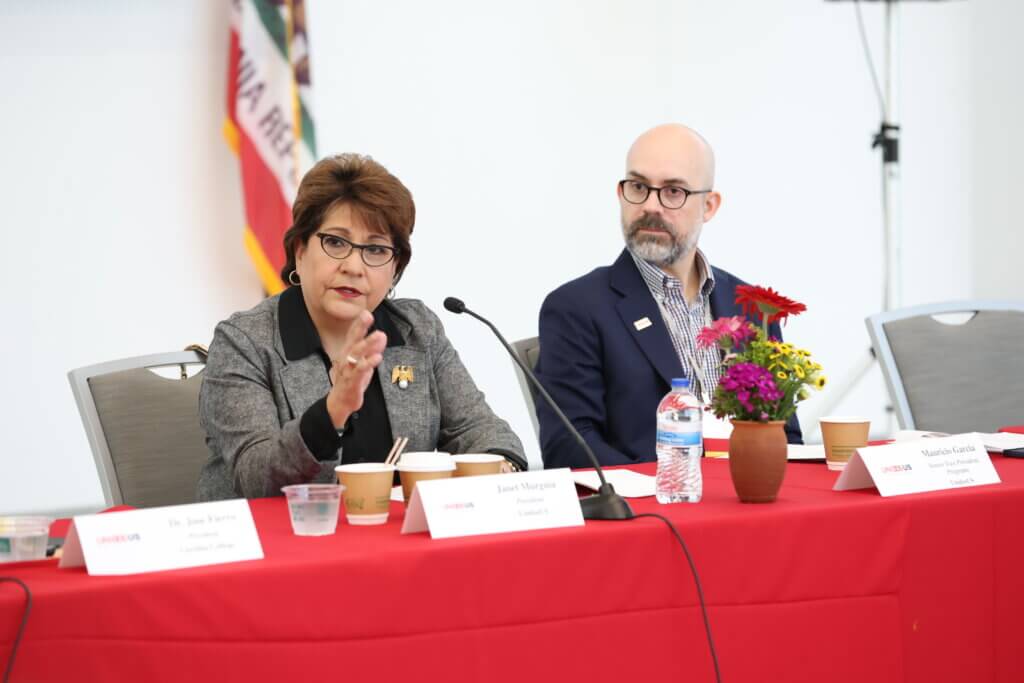Public Service Loan Forgiveness Works for Thousands – Hear from UnidosUS Staffers
On Monday, the Biden-Harris Administration announced a new round of relief for student borrowers, and some of its measures could alleviate a lot of financial and emotional stressors for thousands of Latinos who have dedicated their careers to public service. There are many, even ones working in the UnidosUS Familia network, who probably qualified for the U.S. government’s Public Service Loan Forgiveness program, an initiative developed under the College Cost Reduction and Access Act of 2007. Many spent years waiting for approval, and one of the administration’s measures was to approve a larger volume of cases and discharge those loans as quickly as possible.
Measures like these help to mitigate the U.S. Supreme Court’s July 2023 ruling that struck down President Biden’s executive order on student debt forgiveness. Millions of individuals who had pinned their hopes of debt relief on this decision were devastated.
“The plan would have cleared the debt of half of Latino student borrowers, many of whom face mountains of educational debt,” said UnidosUS President and CEO Janet Murguía in a statement. “We call on the administration and Congress to respond to this decision by taking immediate steps to provide meaningful debt relief for lower-income borrowers.”
In spite of this blow, the Biden-Harris Administration has been steadfast in its efforts to continue chipping away at the student debt crisis.
Under this administration, 872,000 borrowers have been relieved of $62.5 billion through the PSLF program, compared to only 7,000 who had been approved throughout previous administrations.
News of these changes was music to the ears of UnidosUS staffers who have spent years advocating for them. Two UnidosUS policy team members experienced that relief even more personally when their own PSLF applications were finally approved.
UnidosUS Staffers Share Their PSLF Experiences
In the mid-2000s, Esmeralda Lopez, a government affairs strategist who now serves as UnidosUS’s California state director, decided to attend law school to work in social justice and help make laws more equitable for all. The initial loan amount was not $100,000, but it grew over time with increasing interest rates and an inability to pay more than the minimum. As she graduated and moved into the workforce, the road to repayment would be much longer than she anticipated.
“I was expecting to pay the loans with the salary from my job, but my salary, combined with growing interest rates, was not enough to pay the loans off,” she told ProgressReport.co.
Luckily, she began making payments after the U.S. government began PSLF, and while it took a decade of minimal payments, her debt was wiped clean in 2023.
Under PSLF, the federal government will forgive the remaining balance on a borrower’s direct loans if they’ve made the equivalent of 120 qualifying monthly payments under an accepted repayment plan while working full-time for an eligible employer. Those employers include U.S. government organizations at any level as well as non-profit organizations focused on public services such as health, education, emergency management, law enforcement, and military personnel.
Lopez and other UnidosUS staff who have benefited from the program want to make sure that borrowers working in public service know about it and enroll. While obtaining loan forgiveness through this system can be complex and time consuming, recent adjustments have made it easier than when Lopez first signed on. For years, student borrowers who tried to access PSLF had to contend with a confusing application system, loan servicers who provided inaccurate information, challenges with tracking down former employers for verification, and not having the types of loans that were eligible under the program.
“I’d known about the PSLF program since 2009, however, the strict rules on which payment plans qualified for the program, and the lenders not giving clear information, as well as the stories I began hearing of people applying and not having their loans forgiven made it feel like PSLF wasn’t a viable option for me,” said Lopez.
In fact, it wasn’t until she joined UnidosUS in 2021 that she began to see a way forward through that program. That’s where she got a close-up look at the changes to PSLF that UnidosUS was pushing the government to implement. They included a temporary waiver that allowed borrowers who had previously been denied the opportunity to reapply and have their applications reconsidered. The organization also hosted informational webinars for staff and affiliates and partnered with Savi, a social impact technology startup founded by student loan experts and advocates, to provide technical assistance at no cost to staff. At the same time, Lopez started hearing PSLF stories from former law school classmates who had also chosen the public service career track.
UnidosUS Education Policy Project Director Amalia Chamorro had a similar experience. She took out loans for a BA in political science and then even more loans for law school, accumulating $120,000 after seven years of post-secondary education. At that time, it felt doable. Like Lopez, she knew she was more interested in using her law degree in public service than in a law firm, but both still figured those degrees would make it easier to find stable, well-paid public service jobs.
As it turned out, geopolitics and the world economy that responds to it would significantly delay her prospects for following her social justice passions.
“I graduated in the spring of 2002 when the economic fallout of 9/11 was impacting the job market, and it was a struggle to find a job right away,” she recalled. “Typically, over 80% of my school’s class had a job lined up when they graduated (it’s in the 90 percentile now), but that year, only about half of my classmates had secured employment.”
Like Lopez, Chamorro heard about the program around the time that it launched in 2008. But at that time, she was working for a business association.
“It wasn’t until I started working for United Way in 2012 that I could start the 10-year clock working for a nonprofit. I sent in my application and waited to hear back,” she explained, but even then, the rules of engagement were far from clear. “ The response I received was that I didn’t have the type of loan that was eligible under PSLF, but the letter also didn’t tell me what types of loans were eligible or what I would need to do to rectify the situation. I was so let down that I put the whole thing to the side for a while.”
While Chamorro made a seamless non-profit career move from United Way to UnidosUS in 2018, it wasn’t until the topic of PSLF became part of her work that she was fully able to navigate the process. In 2020, the Biden Administration announced a limited-time waiver to reapply for those who had been previously denied, so UnidosUS partnered with Savi to facilitate staff instructional sessions and individual support. Chamorro gained greater knowledge of the program as she helped provide the webinars and began registering for webinars in which Department of Education officials walked hopeful applicants through the waiver process.
These webinars provided her a platform for asking questions, and the momentum of these programs also created the circumstances for Chamorro to discuss and learn about the process through friends and colleagues who were also taking advantage of the temporary waiver.
“Honestly it was talking to people who were going through a similar experience that helped to motivate me to keep trying,” she said.
PSLF Resources for Facilitating the Process
It’s through these success stories of loan forgiveness that many other borrowers keep the motivation to stick with the program, says UnidosUS’s education policy team. That’s because the program sometimes requires multiple rounds of submissions.
“It is definitely a tedious process,” said Lopez, noting that it requires a lot of research, reading, and conversation. But there are certainly steps that others can glean from what she did:
- Read everything about PSFL available on studentaid.gov. This includes the rules, FAQs, and resources on the program.
- Ask if your public service employer offers resources or support to navigate PSLF or ask them to provide opportunities to learn more about the program like hosting a webinar for staff.
- Reach out to colleagues in the public sector whom you know or believe may have gone through the program and ask for tips or even assistance on the application if you get stuck.
Advocates of PSLF recommend that individuals start the application process early in their public sector career and obtain their employer verification while they’re still employed by the institution.
“Getting my past employers to complete the information was the biggest challenge because they had to send me the completed form, then I had to mail it in,” Lopez said. Plus, she says she had to send all of her documentation through regular mail, rather than digitizing and uploading the information. The process is now easier with the PSLF Help Tool, which provides a one-stop-shop to search for a qualifying employer, learn what actions you may need to take to become eligible for PSLF, and generate a PSLF form. There is now only a single form that an applicant needs to complete to certify employment or to receive PSLF.
Getting PSLF Done and Getting on With Life
Lopez says the entire documentation and submission process took her about seven month. Though that might seem like a long time, Lopez considers it worth it when she compares that time to the 16 years she paid on those loans.
“I was stunned at first because until my loans were forgiven, I was skeptical I would qualify because I had been misinformed by student loan lenders in the past about how many qualifying payments I made,” Lopez said, noting that when she got the news last May, she texted friends and family and even called her mother to make sure she wasn’t just imagining the news of her forgiven loan balance. “It took some time for me to wrap my mind around the fact that I was no longer shackled with the student loan debt.”
Charmorro, who reapplied for PSLF in October of 2022, also found out in the fall of 2023 that her loans were forgiven, generating the same reaction as Lopez.
“I was in shock because I went to log in to my account to see about repayment since the payment pause had ended and payments were resuming [in] October 2023. I could not believe my eyes when I saw that my balance was 0. I shouted to my husband to come look and make sure I wasn’t mistaken, and I literally did a happy dance,” Chamorro recalled.
In the months since she received the good news, Lopez has felt a much greater sense of calm and hope for her future, even in an uncertain economy fraught with inflation.
The PSLF news, she says, “means I can save more to buy a house and increase my savings for retirement.”
Charmorro already owns a house with her husband, but she’s elated at what this will mean for her more distant future.
“I can actually think about retiring one day after years of hard work. The Biden-Harris administration has taken significant action to address student borrower issues in various ways, and while there is more work to do, I can personally attest to these actions making a real difference in people’s lives,” she said. “It sure helps to know that after working in public service for 10 years and paying back your loans during that time, that public sector employees are acknowledged and appreciated for our service.”
–Author Julienne Gage is a former UnidosUS staff member and longtime contributor to ProgressReport.co.



